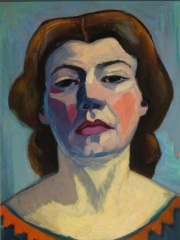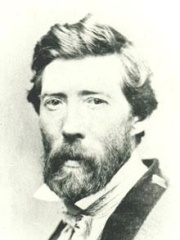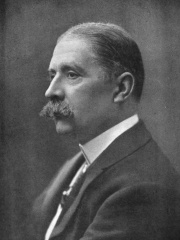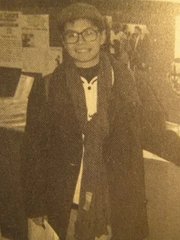PAINTER
Kara Walker
1969 - Today

 Kara Walker
Kara Walker
Kara Elizabeth Walker (born November 26, 1969) is an American contemporary painter, silhouettist, printmaker, installation artist, filmmaker, and professor who explores race, gender, sexuality, violence, and identity in her work. She is best known for her room-size tableaux of black cut-paper silhouettes. Walker was awarded a MacArthur fellowship in 1997, at the age of 28, becoming one of the youngest ever recipients of the award. She has been the Tepper Chair in Visual Arts at the Mason Gross School of the Arts, Rutgers University since 2015. Read more on Wikipedia
Her biography is available in 23 different languages on Wikipedia (up from 21 in 2024). Kara Walker is the 2,012th most popular painter (up from 2,013th in 2024), the 15,122nd most popular biography from United States (down from 15,021st in 2019) and the 156th most popular American Painter.
Memorability Metrics
Page views of Kara Walker by language
Among PAINTERS
Among painters, Kara Walker ranks 2,012 out of 2,023. Before her are Maggie Laubser, William Hart, Thomas Kinkade, Lauren Faust, Mikhail Evstafiev, and Leslie Ward. After her are Jenny Saville, Viktor Lyapkalo, Laurel Holloman, JR, Shamsia Hassani, and Julie Mehretu.
Most Popular Painters in Wikipedia
Go to all RankingsMaggie Laubser
1886 - 1973
HPI: 47.76
Rank: 2,006
William Hart
1823 - 1894
HPI: 47.46
Rank: 2,007
Thomas Kinkade
1958 - 2012
HPI: 47.26
Rank: 2,008
Lauren Faust
1974 - Present
HPI: 46.96
Rank: 2,009
Mikhail Evstafiev
1963 - Present
HPI: 46.94
Rank: 2,010
Leslie Ward
1851 - 1922
HPI: 46.91
Rank: 2,011
Kara Walker
1969 - Present
HPI: 46.47
Rank: 2,012
Jenny Saville
1970 - Present
HPI: 45.82
Rank: 2,013
Viktor Lyapkalo
1956 - Present
HPI: 45.77
Rank: 2,014
Laurel Holloman
1971 - Present
HPI: 45.54
Rank: 2,015
JR
1983 - Present
HPI: 44.81
Rank: 2,016
Shamsia Hassani
1988 - Present
HPI: 44.77
Rank: 2,017
Julie Mehretu
1970 - Present
HPI: 44.27
Rank: 2,018
Contemporaries
Among people born in 1969, Kara Walker ranks 760. Before her are Mariusz Błaszczak, Arabella Kiesbauer, Moussa Saïb, Jorge Eliécer Julio, Shuta Sonoda, and Ronny Weller. After her are Qiu Miaojin, Igor Pamić, Dweezil Zappa, Paulo Alves, Ximena Restrepo, and Domino Harvey.
Others Born in 1969
Go to all RankingsMariusz Błaszczak
POLITICIAN
1969 - Present
HPI: 46.54
Rank: 754
Arabella Kiesbauer
WRITER
1969 - Present
HPI: 46.53
Rank: 755
Moussa Saïb
SOCCER PLAYER
1969 - Present
HPI: 46.52
Rank: 756
Jorge Eliécer Julio
BOXER
1969 - Present
HPI: 46.51
Rank: 757
Shuta Sonoda
SOCCER PLAYER
1969 - Present
HPI: 46.49
Rank: 758
Ronny Weller
ATHLETE
1969 - Present
HPI: 46.49
Rank: 759
Kara Walker
PAINTER
1969 - Present
HPI: 46.47
Rank: 760
Qiu Miaojin
WRITER
1969 - 1995
HPI: 46.46
Rank: 761
Igor Pamić
SOCCER PLAYER
1969 - Present
HPI: 46.45
Rank: 762
Dweezil Zappa
MUSICIAN
1969 - Present
HPI: 46.43
Rank: 763
Paulo Alves
SOCCER PLAYER
1969 - Present
HPI: 46.41
Rank: 764
Ximena Restrepo
ATHLETE
1969 - Present
HPI: 46.39
Rank: 765
Domino Harvey
CELEBRITY
1969 - 2005
HPI: 46.39
Rank: 766
Among PAINTERS In United States
Among painters born in United States, Kara Walker ranks 156. Before her are Elizabeth Catlett (1915), Eastman Johnson (1824), Jacob Lawrence (1917), Kari Byron (1974), Thomas Kinkade (1958), and Lauren Faust (1974). After her are Laurel Holloman (1971), Mark Ryden (1963), Kehinde Wiley (1977), Rachel Dolezal (1977), and Clayton Lewis (1915).
Elizabeth Catlett
1915 - 2012
HPI: 49.05
Rank: 150
Eastman Johnson
1824 - 1906
HPI: 48.80
Rank: 151
Jacob Lawrence
1917 - 2000
HPI: 48.63
Rank: 152
Kari Byron
1974 - Present
HPI: 47.84
Rank: 153
Thomas Kinkade
1958 - 2012
HPI: 47.26
Rank: 154
Lauren Faust
1974 - Present
HPI: 46.96
Rank: 155
Kara Walker
1969 - Present
HPI: 46.47
Rank: 156
Laurel Holloman
1971 - Present
HPI: 45.54
Rank: 157
Mark Ryden
1963 - Present
HPI: 41.56
Rank: 158
Kehinde Wiley
1977 - Present
HPI: 38.56
Rank: 159
Rachel Dolezal
1977 - Present
HPI: 35.99
Rank: 160
Clayton Lewis
1915 - 1995
HPI: 20.86
Rank: 161
































